Mark Creegan, an artist in Jacksonville, FL, is one of my flickr friends. His flickr moniker is onesock which I like alot for its embrace of what many people consider a useless discard.
Creegan’s art which I’ve seen online at his flickr pages and at his website makes use of discarded materials like children’s watercolor paints, rubber bands, magazines and what looks like mayonaise or salad dressing containers from Wendy’s.
In arrangements that are whimsical and surprising Creegan transforms the ordinary into something that verges on the monumental.
Intrigued by the art I saw I emailed the artist some questions to see what lay behind his playful but serious art. Here’s part one of our interview. Part 2 is here.
Interview with Mark Creegan
You use ordinary materials to make comments about art, art history and the larger world of commerce and culture. who are some of your art heroes? and who — if any — are the art villains…or do you think in those terms?
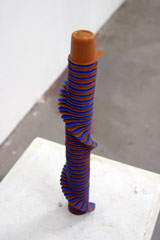
“Twist” which looks like it might be a twisted sock could also be a riff on Brancusi’s endless columns. The piece appears to be a stack of mayonaise or salad dressing cups.
“Art Heroes & Villains” brings to mind some comment I once read drawing similarities between artists and the X-Men (both are extraordinary and social outcasts).
I suppose I make some sort of distinction in my mind about who rocks and who doesn’t, but I really try to be open to acknowledging the virtues of many different forms of art.
I am a promiscuous art nerd because so much impresses me. But, if I have to choose, my personal heroes would be those that have shaped my conception of what is do-able in art and allowed me to expand my artistic sensibilities. When I saw Tony Feher’s work for the first time in NY I was profoundly changed in terms of being aware of the intrinsic qualities of material and of the precise gesture. For these and other reasons I would have to also cite artists like Rachel Harrison, Ry Rocklen, David Hammons, Tom Friedman, Ellen Harvey, Dieter Roth, Jim Shaw, Jessica Stockholder and so many others (certainly Polly Apfelbaum and Rich Tuttle whom you mention later). But anyone making interesting and engaging work is a hero in my eyes.
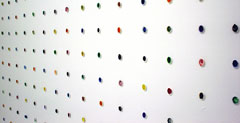
“Fieldwall,” detail, made with used watercolor paints.
I think my commentary is about my relationship to art, or my feelings about it having grown up a lower class white kid wanting a “better” life. Art is my escape, my step up from what I was supposed to become. But I enter it through a base, physical and emotional reaction to material and form.
Also, I have worked at many different types of art businesses –everything from hip art galleries to cheesy frame shops- and the funny thing about it is that each of these constitute a separate artworld that assumes that it is the only “real” one. Each exists in its own bubble and I have been able to float around in all of them. I find this such a funny and pitiful situation and microcosmic of the larger cultural, political, and religious disconnects we witness today. Obviously, I have my own inclination as to which art world I consider more important.
The Kent watercolor floor arrangement is, like many of your works, child-like in its simplicity: Take some materials and arrange them. On the other hand, like minimalists — and like Duchamp with his readymades, you are messing with materials, and that’s transgressive. Is childhood your reference — the artist as child? Or do you go straight to the transgression: I will subvert the intent of this material.
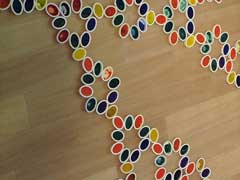
“Kent Watercolors” here seen on the floor ala Polly Apfelbaum.
More often than not it is the material subverting my intention, and hopefully I pick up on it and run with it.
Children subvert the intent of material all the time. Childhood seems packed with transgression that usually involves the simple, small thing transforming into the complex, gigantic thing. Sometimes I think I am just continuing my childhood practice of building forts out of boxes and pillows (when I can tap into it, of course).
The watercolor pieces come from seeing my wife, who is an elementary art teacher, clean out her supplies to get ready for class the next day. She was washing the used sets at the kitchen sink and I thought they looked beautiful.
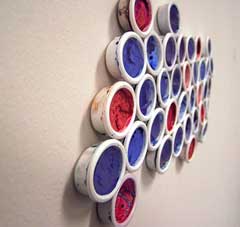
“Watershed” det., Used watercolor pans, tape on wall, Dimensions vary, 2005
I only use the ones that have actually been used by the kids in her classes. And what a contrary thing to then take these objects which come from one context (elementary art ed) into another (high art). I like to think that on some number of refrigerators are little watercolor pictures made out of the objects I am using in a piece for some intellectuals at a gallery. Most of those pictures are probably way better than my stuff.
Of course many art things come to mind here with the Kent watercolor ovals, like minimalism (the fieldwall grid brings to mind Agnes Martin…the floor arrangement, Polly Apfelbaum for example.) When you came through art school was there a prevailing wind blowing towards or against an “ism?” Down with minimalism, up with reductivism?
The professors and students at Florida State all had their inclinations toward or away from reductivism. But, for the most part, these issues were not debated. I think it was like most grad school programs these days where everything is fodder. As a student, I was drawn to the Bay Area Conceptualists and Arte Povera but I wasn’t thinking in hierarchical “movement” terms. My direction in school came from responding to the materials and a distillation of ideas more than wanting to fit in some cultural niche. My grad school experience was very good. I was encouraged to find my own voice.
In a way, your pieces call up lands like Lilliput where tiny people live in one world and we giants live in another. Your art magazines as Serra’s Torqued Elipses for example seem ideal environments for tiny folk to walk in. Want to comment on Serra’s Elipses as objects of commerce and marketing (like magazines) that people of our size walk amongst and feel small?
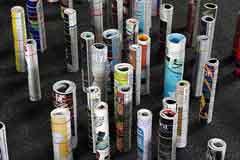
“All My Art Magazines as Rolled Stumps”
These are interesting associations you mention. “Some of My Art Magazines as Serra’s Torqued Ellipses” is an extension of an earlier work called “ All My Art Magazines as Rolled Stumps” , which came from my relationship to these magazines, how they supplemented my education before grad school and fueled my desire to be an artist (they made me feel small and big at the same time). For the first piece, I rolled up all the mags into tubes held together by rubber bands, the number of bands corresponded to the number of articles or images that I remembered influencing me. They were installed standing up referring to some model cityscape. Visually, I found the edges of the pages and interior holes to be beautiful.
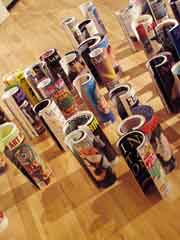
“Some of My Art Magazines as Serra’s Torqued Ellipses”
Months later, I took some of the rubber bands off and noticed the magazines still held the memory of that coil form, the thought of Serra’s Ellipses came immediately. I have only seen images of his work in art magazines so the idea of using the mags themselves as stand-in miniatures (echoing the disparate impression of the real vs the reproduced image) was intriguing to me. I wanted to reverse the experience. I was making a funny.
You were an Art & Drumming Instructor, Gateway Community Services Jacksonville, Florida. Drumming? Got some music experience in your background?
Yup, and theatre also. I went to a local college for undergrad and before becoming an art major, I was in the theatre program where I met most of my closest and dearest friends. On Thursday nights we would gather with other artsy folks, poets, clowns, and hippies along the riverwalk for a vaudevillian type show. I got into performing, drumming, playing guitar and writing songs with my best friend, poet and artist Nestor Gil, during this time. I continue to collaborate with him, both musically and artistically. He has a project called “Elephant See” in which I contribute some banjo and vocal sounds. I also continue to drum with my mentor and undergraduate professor, David Lauderdale, in his drum group.
Those classes were my first foray into teaching. I would bring drums and art supplies to adult halfway houses and teen rehab centers, That was a trip, it reminded me that I could have easily ended up in those shoes. …To be continued





